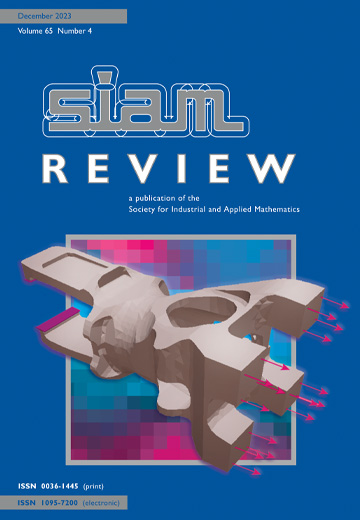Easy Uncertainty Quantification (EasyUQ): Generating Predictive Distributions from Single-Valued Model Output
IF 6.1
1区 数学
Q1 MATHEMATICS, APPLIED
引用次数: 0
Abstract
SIAM Review, Volume 66, Issue 1, Page 91-122, February 2024.How can we quantify uncertainty if our favorite computational tool---be it a numerical, statistical, or machine learning approach, or just any computer model---provides single-valued output only? In this article, we introduce the Easy Uncertainty Quantification (EasyUQ) technique, which transforms real-valued model output into calibrated statistical distributions, based solely on training data of model output--outcome pairs, without any need to access model input. In its basic form, EasyUQ is a special case of the recently introduced isotonic distributional regression (IDR) technique that leverages the pool-adjacent-violators algorithm for nonparametric isotonic regression. EasyUQ yields discrete predictive distributions that are calibrated and optimal in finite samples, subject to stochastic monotonicity. The workflow is fully automated, without any need for tuning. The Smooth EasyUQ approach supplements IDR with kernel smoothing, to yield continuous predictive distributions that preserve key properties of the basic form, including both stochastic monotonicity with respect to the original model output and asymptotic consistency. For the selection of kernel parameters, we introduce multiple one-fit grid search, a computationally much less demanding approximation to leave-one-out cross-validation. We use simulation examples and forecast data from weather prediction to illustrate the techniques. In a study of benchmark problems from machine learning, we show how EasyUQ and Smooth EasyUQ can be integrated into the workflow of neural network learning and hyperparameter tuning, and we find EasyUQ to be competitive with conformal prediction as well as more elaborate input-based approaches.
简易不确定性量化 (EasyUQ):从单值模型输出生成预测分布
SIAM评论》,第66卷第1期,第91-122页,2024年2月。 如果我们最喜欢的计算工具--无论是数值、统计或机器学习方法,还是任何计算机模型--只提供单值输出,我们该如何量化不确定性呢?在本文中,我们将介绍简易不确定性量化(EasyUQ)技术,该技术仅根据模型输出结果对的训练数据,将实值模型输出转换为校准统计分布,而无需访问模型输入。就其基本形式而言,EasyUQ 是最近推出的同调分布回归(IDR)技术的一个特例,该技术利用了非参数同调回归的池-相邻-违反者算法(pool-adjacent-violators algorithm)。EasyUQ 可以生成离散预测分布,这些分布在有限样本中经过校准并达到最佳状态,同时受随机单调性的限制。工作流程完全自动化,无需调整。平滑 EasyUQ 方法通过内核平滑对 IDR 进行了补充,从而产生了保留基本形式关键特性的连续预测分布,包括相对于原始模型输出的随机单调性和渐进一致性。在选择核参数时,我们引入了多重单拟合网格搜索,这是一种对计算要求低得多的近似留空交叉验证方法。我们使用模拟示例和天气预测数据来说明这些技术。在对机器学习基准问题的研究中,我们展示了如何将 EasyUQ 和 Smooth EasyUQ 集成到神经网络学习和超参数调整的工作流程中,我们发现 EasyUQ 与保形预测以及更复杂的基于输入的方法相比具有竞争力。
本文章由计算机程序翻译,如有差异,请以英文原文为准。
求助全文
约1分钟内获得全文
求助全文
来源期刊

SIAM Review
数学-应用数学
CiteScore
16.90
自引率
0.00%
发文量
50
期刊介绍:
Survey and Review feature papers that provide an integrative and current viewpoint on important topics in applied or computational mathematics and scientific computing. These papers aim to offer a comprehensive perspective on the subject matter.
Research Spotlights publish concise research papers in applied and computational mathematics that are of interest to a wide range of readers in SIAM Review. The papers in this section present innovative ideas that are clearly explained and motivated. They stand out from regular publications in specific SIAM journals due to their accessibility and potential for widespread and long-lasting influence.
 求助内容:
求助内容: 应助结果提醒方式:
应助结果提醒方式:


